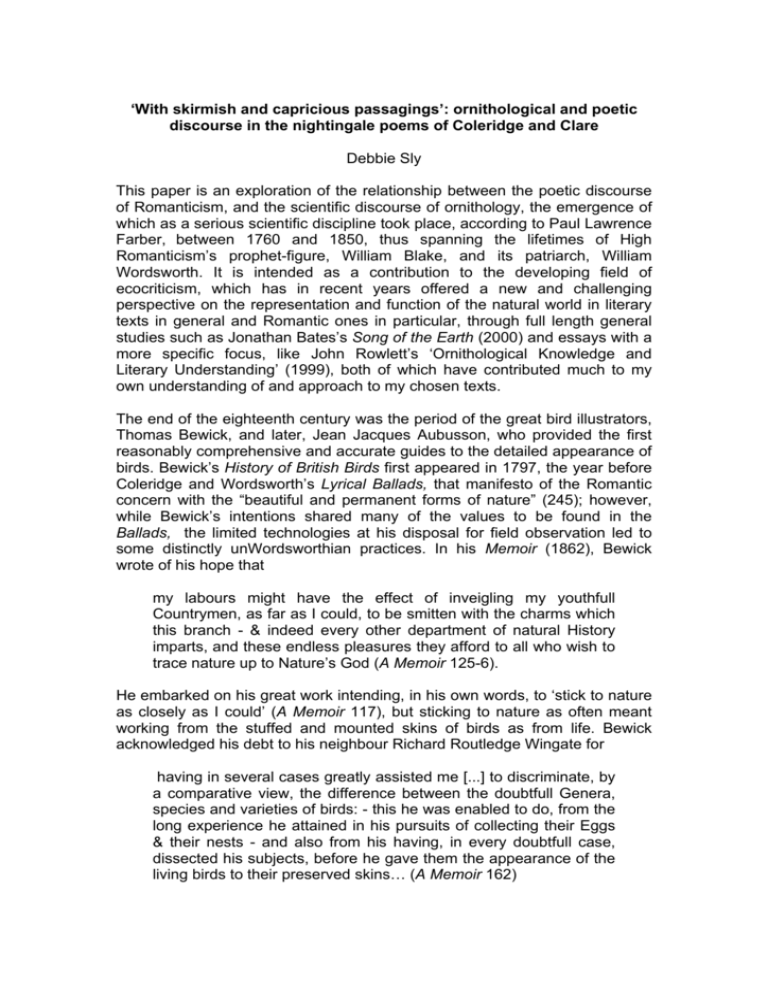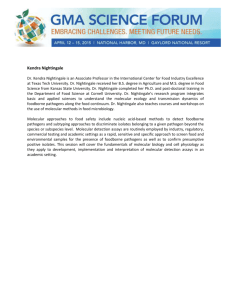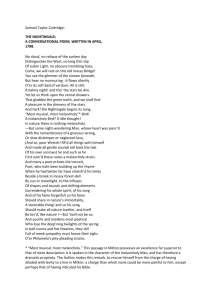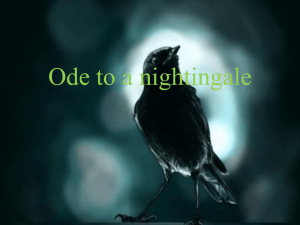'With skirmish and capricious passagings': Nightingales in the poetry
advertisement

‘With skirmish and capricious passagings’: ornithological and poetic
discourse in the nightingale poems of Coleridge and Clare
Debbie Sly
This paper is an exploration of the relationship between the poetic discourse
of Romanticism, and the scientific discourse of ornithology, the emergence of
which as a serious scientific discipline took place, according to Paul Lawrence
Farber, between 1760 and 1850, thus spanning the lifetimes of High
Romanticism’s prophet-figure, William Blake, and its patriarch, William
Wordsworth. It is intended as a contribution to the developing field of
ecocriticism, which has in recent years offered a new and challenging
perspective on the representation and function of the natural world in literary
texts in general and Romantic ones in particular, through full length general
studies such as Jonathan Bates’s Song of the Earth (2000) and essays with a
more specific focus, like John Rowlett’s ‘Ornithological Knowledge and
Literary Understanding’ (1999), both of which have contributed much to my
own understanding of and approach to my chosen texts.
The end of the eighteenth century was the period of the great bird illustrators,
Thomas Bewick, and later, Jean Jacques Aubusson, who provided the first
reasonably comprehensive and accurate guides to the detailed appearance of
birds. Bewick’s History of British Birds first appeared in 1797, the year before
Coleridge and Wordsworth’s Lyrical Ballads, that manifesto of the Romantic
concern with the “beautiful and permanent forms of nature” (245); however,
while Bewick’s intentions shared many of the values to be found in the
Ballads, the limited technologies at his disposal for field observation led to
some distinctly unWordsworthian practices. In his Memoir (1862), Bewick
wrote of his hope that
my labours might have the effect of inveigling my youthfull
Countrymen, as far as I could, to be smitten with the charms which
this branch - & indeed every other department of natural History
imparts, and these endless pleasures they afford to all who wish to
trace nature up to Nature’s God (A Memoir 125-6).
He embarked on his great work intending, in his own words, to ‘stick to nature
as closely as I could’ (A Memoir 117), but sticking to nature as often meant
working from the stuffed and mounted skins of birds as from life. Bewick
acknowledged his debt to his neighbour Richard Routledge Wingate for
having in several cases greatly assisted me [...] to discriminate, by
a comparative view, the difference between the doubtfull Genera,
species and varieties of birds: - this he was enabled to do, from the
long experience he attained in his pursuits of collecting their Eggs
& their nests - and also from his having, in every doubtfull case,
dissected his subjects, before he gave them the appearance of the
living birds to their preserved skins… (A Memoir 162)
The demands of scientific accuracy seem irreconcilable with the spirit of
Romantic natural history expressed by Wordsworth in one of the best-known
poems in Lyrical Ballads, ‘The Tables Turned’ (1798). The speaker exhorts
his friend to abandon the ‘dull and endless strife’ of books:
Sweet is the lore which Nature brings;
Our meddling intellect
Mis-shapes the forms of beauteous things:We murder to dissect.
Enough of Science and of Art;
Close up those barren leaves;
Come forth and bring with you a heart
That watches and receives. (ll. 25-32)
However, Bewick’s work required Science and Art and to supplement
fieldwork. This is his account of how he worked:
As soon as each Bird was finished on the Wood, I set about
describing it from my Specimen - and at the same time consulted
every Authority I could meet with to know what had been said, &
this together with what I knew from my own knowledge, were then
compared, and in this way, I finished, as truely as I could, the
second volume of the History of British Birds [...] Although all this of
thus taking the whole upon me, could not be done, but by close &
indeed severe confinement & application, yet I was supported
under these by the extreme pleasure I felt in depicting these
beautifull & very interesting aireal wanderers of the British Isles ( A
Memoir 117).
Perhaps more in tune with Wordsworth’s recipe was the developing interest in
bird behaviour, exemplified by the work of Gilbert White, that role model for
the great tradition of C19th natural historians (Barber 41). White, as Lynn
Barber points out, described himself as an ‘out-door naturalist, one that takes
his observations from the subject itself, and not from the writing of others’
(White 136). His biographer, Richard Mabey, argues that his greatest legacy
is the tempering of scientific rationalism and acute observation with a distinctly
emotional response to natural phenomena:
Throughout his life he ignored orthodox demarcation lines, between
art and science, fact and feeling.{...}. In fact, the more he reveals
his sensuous enjoyment of the natural world and his sympathy with
the joys and sufferings of its inhabitants, the more he begins to
resemble an early nineteenth century romantic just as much as an
eighteenth century rationalist (12).
This sympathy did not prevent White from shooting rare birds, dissecting
them, and on occasion eating them himself, as he records in this letter to
Thomas Pennant:
On the 13th of April, I went to the sheep-down, where the ringousels have been observed to make their appearance [...] We shot
a cock and a hen; they were plump and in high condition. The hen
had but very small eggs in her, which proves they are late breeders
[...] In their crops was nothing very distinguishable [...] I dressed
one of these birds, and found it juicy and well-flavoured (80-81).
It is important to acknowledge, as John Rowlett points out, that the more
general vogue for natural history was influencing poetry well before the
publication of either Bewick’s or White’s work:
In 1777, twelve years before Gilbert White published his Natural
History of Selborne, John Aiken had argued, in An Essay on the
Application of Natural History to Poetry, that the new knowledge
emerging from the study of natural history could serve descriptive
poets admirably in achieving novelty in imagery and language
(625).
Indeed, Aiken’s exhortation seems belated considering that the first version of
one of the most influential poems of the eighteenth century, James
Thomson’s The Seasons, which contains descriptions of nest-building and
mating behaviour that were especially prized by his readers (Sambrook x),
appeared as early as 1728. In 1767 two writers began to keep the formatted
Naturalist’s Journal designed by Daines Barrington: one was White, the other
the poet Thomas Gray (Mabey 109). White himself wrote verse - the best
known being ‘The Naturalist’s Summer Evening Walk,’ which he included in
The Natural History. While the poem echoes the ecological sensibility which
Mabey sees as one of the most important aspects of White’s prose, it is also a
very conventionally C18th one; the ornithology is dressed in the poetic diction
of the age, including a sprinkling of appropriate epithets: the ‘soft quail’, the
‘vagrant cuckoo’, the ‘clamorous curlew.’ The swallows are apostrophized as
‘Amusive birds!’ while the phrase ‘their infant train’ is drawn from ‘the writings
of another’ - Thomson’s description of birds feeding their young in The
Seasons (685) - a reminder that the literary text cannot represent experience
in any straightforward way. Even when the observer is as accurate as White,
and as determined to take his observations from ‘the subject itself,’ his writing
is always in dialogue with its predecessors. The other side of the reciprocal
relationship between poetry and natural history is illustrated by Thomas
Bewick’s use of quotations from both poems in the Introduction to Volume 1 of
British Birds (xxii, xxiii).
In this paper, I am focusing on a single species: the nightingale, the most
‘poetic’ - or hackneyed - of birds. The poet and novelist Charlotte Smith
remarked that ‘it would be difficult to find anything new to say of that most
charming of our feathered musicians’ (200), having herself written three
sonnets on the subject. The symbolism and myths associated with the
nightingale epitomise the complex capacity of birds to represent not only an
important part of the natural world, but also the poet’s response to it, and the
art through which s/he attempts to represent that relationship and/or
communicate that response.
Birds occupy a richly paradoxical position in the physical world, seeming to
belong equally to air and earth (and to some extent water): less bound than
we are by the laws of gravity, they can symbolise the freedom of the human
spirit, yet physically they share some of the otherness of reptiles. The small
species with which most of us are most familiar seem so fragile and shortlived as to become the proverbial symbol of mortality which proves the
omniscience of God: but precisely that mortality - which our perceptions are
usually too limited to notice - allows them also to stand for immortality. Thus
Keats writes of ‘his’ nightingale, ‘Thou wast not born for death, immortal Bird!’
(stanza 7, l.61), celebrating the unchanging nature of a voice that sings ‘the
self-same song’ (7, 65) to himself and the Biblical Ruth.
Medieval literary representations of the nightingale illustrate this capacity to
represent apparent opposites. The bird could stand for motherhood: Wendy
Pfeffer quotes St Ambrose’s Hexameron, in which ‘she’ hatches ‘her’ eggs by
the warmth of her ‘breast and bosom’ and the sweetness of her song (20); it
could both symbolise the meditative Christian soul (39), and also a rampant
sexuality (3). Then, according to Richard Mabey’s delightful study combining
literary, natural and personal history, The Book of Nightingales (1997), ‘the
mood changed. Influenced by a group of maudlin classical myths which had
only a tangential connection with the real bird, pastoral poets began
representing the nightingale’s song as an outpouring of grief (16). He is of
course referring to the myth of Procne and Philomel, in which the nightingale’s
song becomes the wordless telling of a tale of rape, mutilation and infanticide.
What binds these apparently disparate symbolic functions together is the
gendering of the nightingale: in almost all its literary representations before
the Romantic period it is feminine, despite the reality that only the male bird
sings.
In order to explore the effects of the confluence of these discourses, the
emergent one of ornithology, and the heavily weighted one of poetic tradition,
I have chosen in this paper to focus on two works by poets with a
demonstrable interest in natural history. Both Samuel Taylor Coleridge and
John Clare read White’s Natural History of Selborne: Coleridge annotated his
copy with marginal notes, and (rather unscientifically) referred to it as a
‘sweet, delightful book’ (Mabey 6); John Clare was given a the book by his
publisher (Fitter and Robinson xv), and wrote natural history letters on the
same model. Their nightingale poems draw far more on the natural history of
the bird than those written by Smith, Wordsworth, Shelley, and Keats, who
tend in their bird poems to be interested in the symbolic power of the unseen
singer: ‘No bird, but an invisible thing,/ A voice, a mystery’ (Wordsworth, ‘To
the Cuckoo’ 1802, l15-16).
It is its traditional symbolic associations that Coleridge explicitly discards in
‘The Nightingale, a Conversation Poem,’ one of his contributions to the first
edition of Lyrical Ballads . The poem opens with an invitation to the reader to
share the experience of hearing the nightingale’s song:
No cloud, no relique of the sunken day
Distinguishes the West, no long thin slip
Of sullen Light, no obscure trembling hues.
Come, we will rest on this old mossy Bridge!
You see the glimmer of the stream beneath,
But hear no murmuring: it flows silently
O’er its bed of soft verdure. (ll.1-7)
In preparation for the performance of the nightingale, all other effects are
extinguished: day is banished, the stream silenced, the stars dimmed. Yet the
annunciatory line, ‘And hark! the nightingale begins its song,’ (12) is followed
by the bathetic intrusion of what is carefully signalled as quotation: “Most
musical, most melancholy”* bird - an intrusion intensified by the asterisk that
sends the reader out of the poem to the foot of the page where ‘the Author’
offers a self-deprecating defence of his temerity in having apparently ‘alluded
with levity to a line by Milton: a charge than which none could be more painful
to him, except perhaps of having ridiculed his Bible.’ Nonetheless, the
quotation, and Coleridge’s critique of the projection that informs it - the
tendency of the listener to the song to fill ‘all things with himself/ And [make]
all gentle sounds tell back the tale of his own sorrows’ (19-21) - stand, to be
followed by an injunction to the would-be poet to abandon the conventions of
the past and even the conscious effort of art,
to the influxes
Of shapes and sounds and shifting elements
Surrendering his whole spirit, of his song
And of his fame forgetful. (27-30)
Yet this is an impossible project: his own experience, shared with William and
Dorothy Wordsworth is still a mediated one: ‘My Friend and my Friend’s sister!
we have learnt/ A different lore’ - both the Romantic lore that ‘Nature’s sweet
voices’ are ‘always full of love/ And joyance’ (40-43), rather than melancholy,
and the natural history which teaches that the nightingale who sings is not,
after all she but he, and that the song is part of the male’s competitive display:
They answer and provoke each other’s songs With skirmish and capricious passagings
And murmurs musical and swift jug jug
And one low piping sound more sweet than all – (58-61)
The edition of The Natural History of Selborne owned by Coleridge was not
published until 1802 (Martin 174-5), so the ‘lore’ that informs it was perhaps
gained from Bewick’s book - especially as Coleridge’s bird is sharply visible:
On moonlit bushes ...
You may perchance behold them on the twigs,
Their bright, bright eyes, their eyes both bright and full,
Glistning, (64-68)
and Bewick quotes the same line from Milton in his description of the bird ( A
History of British Birds I 233).
The ornithologically correct sexing of his nightingale allows Coleridge to
produce a very different poetic association from the traditional one between
the bird and a symbolic femininity. Here femininity is represented by the figure
of the ‘most gentle maid’ who
at latest eve
(Even like a Lady vow’d and dedicate
To something more than nature in the grove)
Glides thro’ the pathways; she knows all their notes, (71-74)
Despite her nunlike dedication, the maid not only knows those songs of
sexual display, she also watches (according to Freud a rather more sexual
activity than listening) the performance, which is described in language that
suggests its sexual function:
And she hath watch’d
Many a Nightingale perch giddily
On blosmy twig still swinging from the breeze,
And to that motion tune his wanton song,
Like tipsy Joy that reels with tossing head. (82-86)
If, as Richard Holmes suggests, the ‘maid’ is partly based on Dorothy
Wordsworth (192), then the sexual rivalry through song of the nightingales (
those skirmishes and capricious passagings) may allude to the relationship of
Coleridge and William, whose notes she certainly knew, even if the journal
entry in which she refers to the moment that inspired the poem does not
suggest any particular expertise in ornithology: ‘Met Coleridge as we were
walking out. Went with him to Stowey; heard the nightingale; saw a glowworm.’ (14) The virtuoso song of the male nightingale to a silent invisible
female listener validates the emotional outpourings of the poet as an
acceptably – indeed essentially - masculine performance.
John Clare’s poem, ‘The Nightingale’s Nest’ belongs to a group of bird poems
written between 1825-30. It opens, like Coleridge’s, in conversational style
with an invitation to join the speaker in listening to the nightingale:
Up this green woodland ride let’s softly rove,
And list the nightingale - she dwells just here.
Hush! let the woodgate softly clap for fear
The noise might drive her from her home of love; (ll. 1-4)
However, Clare takes a more indirect route to an experience that is in itself
problematic: the reader is not just being invited to ‘list’ the nightingale; s/he is
being also taken to view ‘her’ nest. But not yet - as with Coleridge’s poem, the
experience is delayed: the next 36 lines establish Clare’s credentials as an
ornithologist. They describe his success in the first aim (hearing the bird)- but
his failure in the second: ‘To find her nest and see her feed her young.’(14)
Indeed, the vivid description in the poem of the singing nightingale,
Her wings would tremble in her ecstasy,
And feathers stand on end, as ‘twere with joy,
And mouth wide open to release her heart
Of its out-sobbing songs. (22-25)
belongs to a fleeting moment from the past experience of the poet. What the
reader really experiences is not so much the bird or the song - ‘our presence
doth retard her joys’ - but the nest, described in exquisite and accurate detail:
dead oaken leaves
Are placed without and velvet moss within,
And little scraps of grass, and - scant and spare,
Of what seem scarce materials - down and hair;
For from men’s haunts she nothing seems to win.
(For a fascinating discussion of the significance of nests in Clare’s poetry, the
reader is recommended to Jonathan Bate’s The Song of the Earth pp.153175.)
When I first read this poem, I was deeply disconcerted by its combination of
authoritative knowledge of the bird’s nesting habits (far more detailed than
that offered by White or Bewick), the immediacy of the evocation of the
experience of bird-watching (‘stoop right cautious ‘neath the rustling boughs’
(46)), the rejection of even Coleridgean Romantic ‘lore’ (it is merely ‘happy
fancies’ that ‘shapen her employ’ as joyful (26-7)) with the traditional
misapprehension about the sex of the singing bird. I even wondered if
conventional ornithology had got it wrong, and Clare really had seen a hen
bird singing by her nest , until I found in his prose writing on the subject that
he was ‘almost certain that the female is silent and never sings’ (Robinson
and Fitter 45).
Why then, in a poem otherwise so accurate (it is an implicit correction of
another misapprehension, that nightingales only sing at night) does Clare
include what he suspected to be a fundamental error? The most obvious
explanation is that his poetic technique was developed as much from C18th,
as from Romantic models; conscious of the potential tension between writing
verse and natural history, he retains this one, fundamental, element of the
nightingale tradition. There are other reminders of the literary nature of this
text - possible echoes of Keats’s ‘Ode to a Nightingale’ (1819) in the
association between the nightingale and summer rather than spring, the
reference to flowers, the moment in which the nightingale moves away, and
some of the vocabulary (although I rather cherish the idea, suggested by
Clare’s description of Londoners ‘listening very attentive by the side of a
shrubbery’ to what they thought was a nightingale, but he recognised as a
thrush (Robinson and Fitter 42), that Keats’s great ode is based on a
misapprehension).
Because its descriptive passages are so vivid, the poem at first reading might
seem to bear out the criticism that Clare’s nature poetry is nothing more than
descriptive; however it is also arguably Romantic in the empathy between
poet and bird: this nightingale – like Coleridge’s - reflects Clare’s own poetic
subjectivity. Clare’s bird is, like him, a recluse, a shy singer in the russet
brown of the rural working class (Lucas 44); the intrusion of the reader (not
the poet who has known her of old) poses a risk described most graphically
as the ‘choking fear’ (60) that silences the nightingale. The poet draws the
reader back from the nest:
So even now
We’ll leave it as we found it: safety’s guard
Of pathless solitudes shall keep it still. (61-63)
But the harm may be done: the poet has already instructed the reader to ‘put
that bramble by/ Nay, trample on its branches’ (55-56) to see the nest, to
violate the singer’s desire to spend her life ‘unseen.’ In a similar way, Clare’s
own songs invited intrusion into his own life by ‘inquisitive London visitors
wanting to interview the “peasant poet”’ (Lucas 3). And here the sexing of the
nightingale may, after all, be more than a matter of tradition: in his
powerlessness, especially to defend himself from such intrusive eyes, Clare
may well have felt an empathy with femininity - an empathy so potentially
threatening that in the poems he wrote during his periods of mental illness, he
borrowed such notably masculine personae as Byron and Tom Spring the
boxer (Storey 152). And the anomalous song of the hen nightingale,
defending not a territory but only a nest, might well represent the unlikely
poetry of a farm labourer – who in the end did not even have a nest.
To sum up: both Coleridge and Clare centre their poems on what might be
termed an ornithological experience: both invite the reader to accompany the
speaker in search of the nightingale; unlike their contemporaries, both
describe its habitat and represent the nightingale in strongly visual, rather
than merely aural terms; both are unusually accurate in their knowledge of the
bird’s habits. However the reader is constantly reminded that these are literary
texts, through their direct or indirect reference to other poems, through their
rejection or use of poetic convention, and that they are the product of their
literary moment by the subjectivity which competes with objective description,
and by the complexity and ambiguity of the projections and symbolizations
which intervene in and enrich the experience they represent.
Bibliography
Barber, L. The Heyday of Natural History. London: Jonathan Cape, 1980.
Bate, J. The Song of the Earth. London: Picador, 2000.
Bewick, T. A History of British Birds Vol.I. Newcastle upon Tyne: Frank
Graham, 1971 (facsimile of 6th Edition 1826).
Bewick, T. A Memoir. Oxford: Oxford University Press, 1979.
Clare, J. Selected Poems. London: Penguin, 2004.
Farber, P.L. The Emergence of Ornithology as a Scientific Discipline: 17601850. Dordrecht-Holland : D. Reidel Publishing Company, 1982.
Holmes, R. Coleridge Early Visions. London: Hodder & Stoughton, 1989.
Lucas, J. John Clare. Tavistock: Northcote House Publishers, 1994.
Mabey, R. Gilbert White. London: J.M. Dent, 1993.
Martin, E.A. Gilbert White. London: Halton & Company, 1934.
Pfeffer, W. The Change of Philomel. American University Studies: Peter
Lang, 1985.
Robinson, E. and Fitter, eds. John Clare’s Birds. Oxford: Oxford University
Press, 1982.
Rowlett, J. “Ornithological Knowledge and Literary Understanding.”
Ecocriticism, New Literary History 30, No.3 (1999): 625-649.
Smith, C. The Poems of Charlotte Smith, ed. Stuart Curran. Oxford: Oxford
University Press, 1993.
Storey, M. The Poetry of John Clare. Basingstoke: Macmillan, 1974.
Thomson, J. The Seasons and the Castle of Indolence, ed. James Sambrook.
Oxford: Clarendon Press, 1972.
White, G. The Natural History of Selborne second edition. London: Bickers &
Son, 1876.
.
Wordsworth, D. The Journals of Dorothy Wordsworth, ed. Mary Moorman.
Oxford:Oxford University Press, 1971.
Wordsworth, W. Poetical Works, ed. Thomas Hutchinson. Oxford: Oxford
University Press, 1969.
Wordsworth, W and Coleridge, S.T. Lyrical Ballads, ed. R.L. Brett and A.R.
Jones. London: Methuen, 1968.
.




